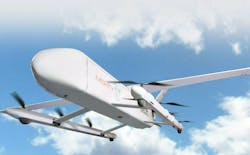MightyFly debuts third-gen autonomous delivery eVTOL
SAN FRANCISCO, Calif., - MightyFly in San Leandro, Calif. unveiled its third generation of the Cento aircraft, an autonomous hybrid electric vertical take-off and landing (eVTOL) cargo aircraft designed to carry one hundred pounds of cargo for six hundred miles.
The new eVTOL incorporates several features that enable operational efficiency, the ability to accommodate a wide range of payload center of gravity, an autonomous center of gravity determination, and a larger cargo bay. The 2024 Cento features a tandem wing design to enable a large trim of the aircraft center of lift; the use of structural conductors to increase reliability and reduce weight; a composite structure to reduce empty weight and increase payload capacity; a modular design to optimize maintenance; and the use of the canard as landing gear to lower drag and drive efficiency.
The new eVTOL will also present improved operational efficiency through MightyFly’s Autonomous Load Mastering System (ALMS) component, which will enable the aircraft to autonomously open and close its cargo bay door, receive and eject packages into and from the cargo bay opening, move and secure packages in the cargo bay via an internal positioning and locking system, and sense and compute weight and balance.
All of these tasks will be done autonomously, without requiring an operator to reposition the packages inside the aircraft, which will help minimize the ground operation resources required to run and operate the MightyFly autonomous aircraft. MightyFly is currently working with Agility Prime and Air Mobility Command in the development of the ALMS feature to solve the U.S. Air Force’s most pressing autonomous aerial logistics needs.
Additionally, MightyFly’s third-generation aircraft has been designed to accommodate a relatively large range of payloads’ center of gravity, which allows for a high degree of variance in cargo contents, densities, constitutions, loading order, and tie-down positions. This design attribute is expected to be a key technology differentiator for the Cento platform and its utility to be extremely valuable and competitive in the market.
The aircraft’s cargo bay is larger than its second-generation predecessor, the size of which was set based on extensive market research to optimize the number of packages for the 100-pound payload capability. This enlarged cargo bay will allow the delivery of larger packages and goods, including the traditional cooler boxes used to transport donor organs for transplantation and blood bags. It will also benefit additional use cases and businesses in the industries of logistics, manufacturing, healthcare, pharmaceutical, retail, automotive, and oil and gas, as well as organizations performing humanitarian and disaster relief work, and government defense teams executing various logistics and resupply missions.
In the fall of 2024, MightyFly will publicly debut its autonomous cargo aircraft delivery flights in Michigan, demonstrating point-to-point autonomous delivery use cases to partners and potential customers.
The company is also scheduled to demonstrate its autonomous loading, unloading, and balancing of packages capability to the U.S. Air Force in early 2025 and to perform additional proof of concept programs.
